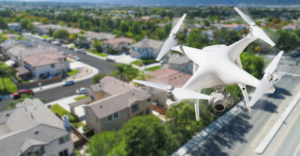
By Kat Beatty
One of the most rapidly growing new technologies is the use of drones for recreational and professional use, with a total “[o]f…865,505 drones registered with the [Federal Aviation Administration] FAA.”[1] Due to the growing number of drones, in 2016, Congress required the FAA to establish regulations for the usage and identification of drones, called the Standard Remote ID requirement.[2] Part of the federal regulations “require drone operators to keep drones within visual observation at all times, fly drones no higher than 400 feet, refrain from flying drones over human beings.”[3] The rule was designed to allow the FAA access to monitor drones due to growing concerns about air traffic, national security, and the protection of people and things on the ground.[4]
One of the largest concerns is the impact of drones on the Fourth Amendment constitutional protection against unreasonable searches and seizures. The Supreme Court has found a search occurs “when the government intrudes on an individual’s reasonable, or justifiable, expectation of privacy.”[5] However, what someone “knowingly exposes to the public, even in his own home or office, is not a subject of Fourth Amendment protection.”[6] The Supreme Court has found that flying a plane over someone’s property does not invoke the Fourth Amendment and what is visible to the naked eye has no reasonable expectation of privacy.[7] A person can only have a reasonable expectation of privacy when it is something “that society is prepared to recognize as ‘reasonable.'”[8]
The only line the Court has drawn on the limitations is when a piece of technology, such as a thermal imaging camera, allows law enforcement to “explore details of the home that would previously have been unknowable without physical intrusion.”[9] The Court has frequently recognized that technology has changed the role of the Fourth Amendment, but has continuously declined to hear any case concerning the use of drones by law enforcement.[10]
The lower courts are divided as to whether a drone falls under a different categorization than planes or other types of technology, such as cellphones. In the case of Brennan v. Dickson, the D.C. Circuit was asked to determine if the FAA’s Remote ID requirement violated the Fourth Amendment right to privacy. [11] The Court distinguished drones from cellphones because a cell phone provides an intimate view of the life of the owner, whereas a drone does not give the same level of detail.[12] The Court also found that a drone user, by flying in the open air, has no reasonable expectation of privacy.[13] Contrastingly, in the case of Long Lake Township v. Maxon, the Court of Appeals for Michigan was asked to determine if the Township flying a drone over private property, to find them in violation of a zoning ordinance, was a violation of the Fourth Amendment.[14] The Court found that “[d]rones fly below what is usually considered public or navigable airspace.”[15] The Court distinguished drones from the types of plane searches allowed in Riley because of their low-altitude flight and because drone surveillance requires targeting rather than something generally visible.[16]
At this time, it is unclear what stance the Supreme Court will take if they choose to hear a case regarding Fourth Amendment protections with drones. It will most likely be determined by whether the Court believes there is a reasonable expectation of privacy from drones or if they have become so commonplace as to reject an expectation of privacy.
[1] Brennan v. Dickson, 45 F.4th 48, 54-55 (D.C. Cir. 2022); see Drones by the Numbers, FAA (May 31, 2022), https://www.faa.gov/uas/resources/by_the_numbers/.
[2] Brennan v. Dickson, 45 F.4th 48, 53 (D.C. Cir. 2022).
[3] Long Lake Twp. v. Maxon, 336 Mich. App. 521, 539 (Mich. Ct. App. 2021).
[4] Brennan v. Dickson, 45 F.4th 48, 53 (D.C. Cir. 2022).
[5] Long Lake Twp. v. Maxon, 336 Mich. App. 521, 530 (Mich. Ct. App. 2021) (quoting People v Brooks, 405 Mich. 225, 242 (Mich. 1979)).
[6] Long Lake Twp. v. Maxon, 336 Mich. App. 521, 530 (Mich. Ct. App. 2021) (quoting Katz v. United States, 389 U.S. 347, 351 (1967)).
[7] Cupp v. Smith, No. 20-cv-03456-PJH, 2021 U.S. Dist. LEXIS 30549, at *15 (N.D. Cal. Feb. 17, 2021) (citing Florida v. Riley, 488 U.S. 445, 450 (1989); California v. Ciraolo, 476 U.S. 207, 215 (1986)).
[8] United States v. Tuggle, 4 F.4th 505, 513 (7th Cir. 2021) (quoting Katz v. United States, 389 U.S. at 360-61 (1967) (Harlan, J., concurring)).
[9] United States v. Tuggle, 4 F.4th 505, 516 (7th Cir. 2021) (quoting Kyllo v. United States, 553 U.S. 27, 40 (2001)).
[10] United States v. Tuggle, 4 F.4th 505, 515 (7th Cir. 2021) (citing Dow Chemical Co. v. United States, 476 U.S. 227 (1986)).
[11] Brennan v. Dickson, 45 F.4th 48, 53 (D.C. Cir. 2022).
[12] Brennan v. Dickson, 45 F.4th 48, 63 (D.C. Cir. 2022).
[13] Brennan v. Dickson, 45 F.4th 48, 61 (D.C. Cir. 2022).
[14] Long Lake Twp. v. Maxon, 336 Mich. App. 521 (Mich. Ct. App. 2021).
[15] Long Lake Twp. v. Maxon, 336 Mich. App. 521, 540 (Mich. Ct. App. 2021).
[16] Long Lake Twp. v. Maxon, 336 Mich. App. 521, 538 (Mich. Ct. App. 2021).
